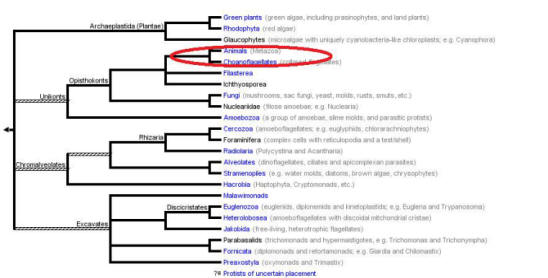Classification
Domain:
Eukarya - The most general of
classifications. This organism contains membrane bound
organelles as well as a true nucleus.
For your viewing pleasure,
another interesting organism from this domain on
MultipleOrganisms.net,
the
Giant Squid!
Kingdom:
Animalia -
This organism is heterotrophic, multicellular,
motile at some stage in its lifetime, and does not contain cell walls.
For your viewing pleasure,
another interesting organism from this kingdom on
MultipleOrganisms.net,
the
Portuguese Man of War!
Phylum:
Porifera - Sponges lacks true
tissues, but it have numerous different cell types. Their
cells are totipotent, meaning
that they can differentiate and make a whole new identical
organism. They are also suspension feeders who use their
individually specialized cells to obtain food. Finally,
sponges are asymmetrical, which allow for no cephalization.
Class:
Demospongiae - This class of sponge have
skeletons that are usually composed of spongin fibers or silica spicules.
They also tend to have a variety of growth forms as well as a
variety of places that they can live. Apart from this they
are very large and sessile.
Order:
Hadromerida - This
order of sponges have a radially structured body, spicules and
organic material that make up the skeleton, along with a simple
cortex. They also tend to live in small holes that they
have dug themselves into.
Family:
Tethyidae
- Teth, giving rise to the Greek theta, could possibly be
derived to explain the mouth-like opening to the sponge
structures. In the original Greek context, theta referred
to the
voiceless dental plosive.
Genus:
Tectitethya
- In Greek, Tect refers to a carpenter or builder. This
could explain the particular genus of sponge because this group
usually lives in large structured "buildings" representing
colonies of many sponge organisms.
Species:
Tectitethya crypta -
This species was originally
discovered in 1945 by Werner Bergmann and later named by Dr. M.
W. Laubenfels.
The name crypta comes from a Latin word meaning crypt, probably
referring to the vast size of this organism and the crypt-like
osculum in which filtered water exits the organism.
Taxomony:
Posted below are a few taxonomic trees both regarding the
species, Cryptotethya (Tectitethya) crypta, and sponges in general.
Hopefully, this will help better understand where and what
sponges came from and how they stand as the link between single-cellularity
and the multi-cellular animals!!! For more information on
Cryptotethya crypta's taxonomy please visit:
this webpage.

This tree represents the super-groups
that divide all eukaryotic organisms. It is primarily
based on the classification and designation of organisms into
group in which they are genetically similar. It also shows
points in evolution in which a Protist (Choanoflagellate) could
have given rise to another group, like the animals.

This tree represents a more specific
classification of animals into 14 separate phylums. You
can see that some specific animals are segregated
morphologically, in the case of Silicea and Calcarea sponges.
Return Back to Top
Continue Onward to Habitat...